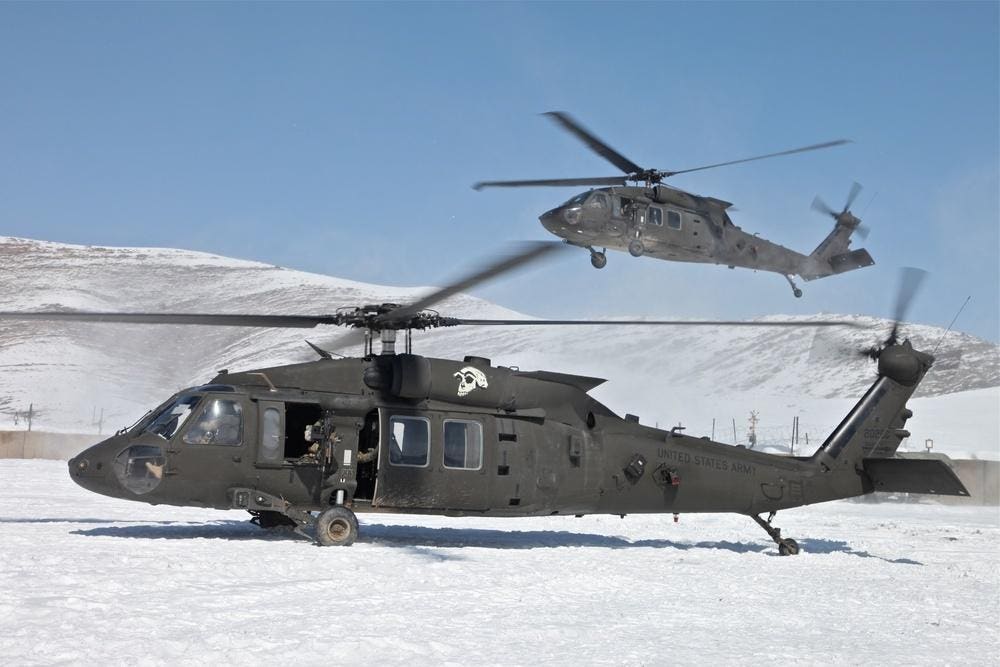The U.S. Army is preparing to downsize its UH-60 Black Hawk helicopter fleet. Does that signal a downturn for Sikorsky?
As things stand, the Army has about 2,135 UH-60s in total. Major General Mac McCurry, the Army’s Aviation Center of Excellence commander, recently told Defense News that the Service wants to cut its fleet by around eight percent to free up funding for the Bell V-280 – the advanced tiltrotor transport poised to replace many of the Black Hawks.
Acquiring the V-280, which was selected for the Army’s Future Long-Range Assault Aircraft (FLRAA) requirement, will take some financial commitment. The FLRAA contract award is worth up to $1.3 billion, $232 million of which the Army will have ponied up by summer 2024.
Cutting about 157 Black Hawks, as the Army says it plans to do, from its inventory should save some money. How much is unknown, and the Army has not provided a savings projection. But estimates put the total annual cost of Black Hawk helicopter maintenance somewhere north of $1 billion.
By paring its Black Hawk complement down to a desired 1,978 aircraft, the Army will save some portion of the above approximate figure. The Service says it will look to retire the oldest aircraft in its inventory – UH-60A and UH-60L models – which could represent greater savings since they are likely the highest-time helicopters in the active Army. (Cuts to the National Guard and Army Reserve fleets are not planned.)
Logically, the savings that will accrue to the Army will come out of Sikorsky’s bottom line given its sustainment contracts for the Black Hawk. The importance of the multi-service (Army, Navy, Air Force), internationally-sold UH-60 to the Lockheed Martin subsidiary is hard to overstate.
In fact, in a press release recognizing the 5,000th UH-60 built last January, a UH-60M for the Army, Sikorsky President Paul Lemmo intoned, “Sikorsky, as a company, has been forged by the Black Hawk.”
Lemmo is undoubtedly right. While there isn’t an official price tag for each UH-60, the different models are estimated to cost between roughly $7.5 million to $25 million per copy.
While that’s a broad estimate, consider the revenue that the sale of Black Hawks to the Army has represented for Sikorsky over the last 40-plus years of UH-60 service. Then reflect on the 5,000 built for all customers. Black Hawks have brought the company tens of billions of dollars over the years, leaving aside revenue from sustainment.
And they’re still doing so. In mid-2022, the Army awarded Lockheed-Sikorsky a tenth UH-60 Black Hawk multiyear production contract worth $2.3 billion. It covers the production of 120 UH-60Ms with an option for an additional 135 helicopters for the Army. Deliveries are set to continue through 2027.
That’s likely why Sikorsky said in an emailed response to my questions that, “We do not see this having a significant impact to our sustainment business.”
The Army, Sikorsky says, recently stated the Black Hawk will be in front line service another 40-60 years. Along with foreign customers (the Black Hawk has been acquired by 35 nations), the Army is continuing to “invest in and operate the latest-generation platform with digital capabilities, upgraded mission performance, and lower operational costs,” the company asserts.
“Sikorsky is also committed to working closely with the U.S. Army to modernize the H-60M, which will continue to operate well into the 2070s.”
Sikorsky points to a recent sources sought notice from the Army which it says affirms potential for a procurement “of up to 255 more Black Hawks for the Army, DOD agencies, foreign militaries and other U.S. government agencies for delivery between 2027-2032.”
All that said, Sikorsky did not provide an estimate of the sustainment revenue it will forgo when the 157 UH-60s are retired. Its argument that continued sustainment of the Army inventory for another five decades and the active employment of a “hot” assembly line for Black Hawks for the balance of the 120 UH-60s the Army last ordered, paired with new U.S. orders of 200 or more (leaving out potential future foreign military sales) will sustain its business is a persuasive one.
But it’s one that Lockheed Martin-Sikorsky may not wish to make too loudly with the Army’s decision on its Future Armed Reconnaissance Aircraft (FARA) on the near horizon. As with FLRAA, Sikorsky is again locked in competition with Bell to provide an advanced Scout/Attack helicopter to the Army which is slated to make a selection decision in Fiscal 2026.
Sikorsky’s Defiant X (on which it partnered with Boeing) lost out to the V-280 for FLRAA. Many observers expect that Sikorsky may have an edge in the FARA competition given industrial base concerns and its previous loss.
A company well-fixed with future Black Hawk work and in position to compete for an AH-64 Apache attack helicopter replacement in the more distant future might be perceived as less at risk if its Raider X prototype is not selected.
Irrespective of the outcome of FARA (the winner is expected to begin entering service in Fiscal 2031), the Army’s fleet of UH-60s will slowly dwindle as time, changes in technology and warfare go forward. The loss of 150 or so Black Hawks to maintain may not look like much now but a decade-plus in the future things might look different.
Read the full article here





